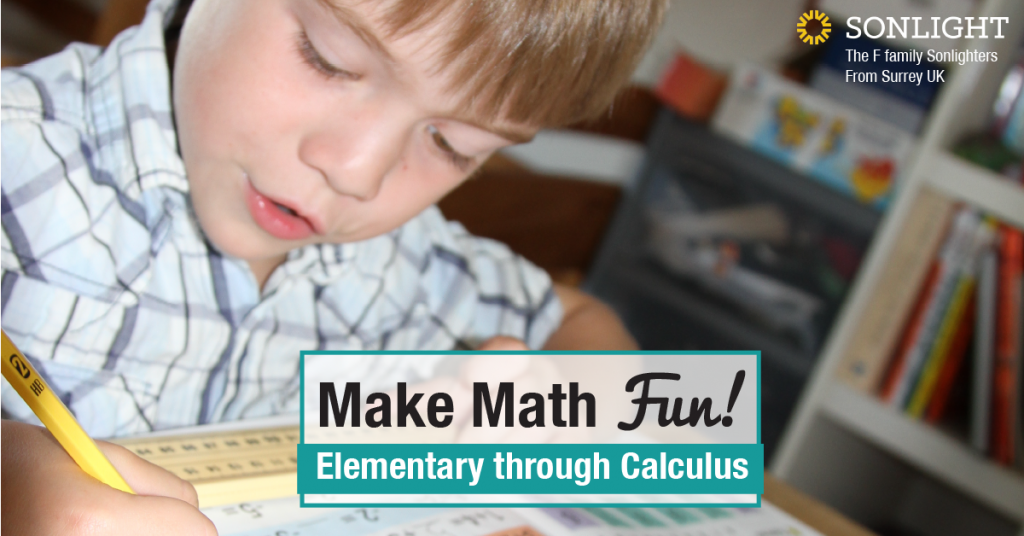Math seems to be the subject that gets the worst reputation. Some kids would rather have a root canal than do their math work. Why is this?
I think that there are several answers to that question. For the most part, I think math can tend to feel repetitive and thus boring to a lot of kids. Even children who excel at math have their slumps. To combat these periods of discouragement and dread, we need to try to keep math time fresh and tear-free. Here are 7 tips for keeping things novel and engaging during math lessons.
1. Skip Assignments Your Child Has Mastered
No one likes to spend their time on a meaningless assignment. Most math curricula include a lot of practice and repetition because that’s how many children learn.
It’s better to have too much than not enough, right?
But that doesn’t mean that every child will need the extra practice. If your child has already mastered a concept, skip the practice and review work.
Keep going forward. A lot of children thrive on tangible progression, so spending minimal time on review can help your child enjoy math time more.
I recommend you set aside any pages that you skip so that if, at some point, you see that your child actually does need a little more practice, it will be easy to go back and review.
2. Complete Problems Orally Using Concrete Manipulatives
Math means pencils. At least, that’s what a lot of kids believe. So change things up every once in a while and go through their work orally, allowing them to use manipulatives to solve problems.
My favorite set of concrete manipulatives for math is the RightStart set available here.
You can still use the same problems from the worksheet, but instead of writing them down, let your kids use blocks, toys, or an abacus to show you how they figured out the answer.
If you would like to keep a record of it, write their answers down on the page and note on the top that you completed the lesson orally.
3. Cut Down the Number of Problems
My kids have always had a tendency to be overwhelmed by a page full of math. Even if they know how to do it, a workbook page filled with problems on the front and back is overwhelming for them. When that panic happens, cut down the amount of work by marking out some of the problems.
Do the evens (or the odds). Do three problems in each section, or choose five problems from each half of the page.
If your child needs the practice, by all means, have them do it. You can make it less overwhelming by using a clean sheet of paper to block half of the workbook page. You may also try breaking up work sessions. Try having them complete 10 questions and then take a break.
4. Allow Them to Drill Using Electronics
Repetition and drill is a big part of math fluency. Kids need to be able to quickly recall facts in order to progress to more difficult levels of math instruction.
Online digital games can motivate kids to drill math facts.
For kids who enjoy having some screen-based game time during the school day, you might find online math games are a powerful motivator for kids to finish their math work. For example, “When you finish your math work, you may go play Math Slicer for 15 minutes.”
5. Check in Often
It can be discouraging for your homeschoolers when they complete a math assignment and then discover they did the whole thing wrong!
Don’t let your children practice mistakes. Make sure they are grasping the concept by checking in often.
If you see a mistake, correct it immediately and work the problem together, showing them their mistake. Practice doesn’t necessarily make perfect, but practice does make permanent. Perfect practice makes perfect, so don’t let your child practice math wrong. Stay close by and check in every few minutes, gradually giving them more space as they begin to master the concept.
6. Show Math Concepts in Real Life Scenarios
Real life scenarios present themselves multiple times every single day. We simply need to point them out to show our children how important math is in real life so we have an answer for the cry, “I’ll never use this again. I don’t know why you’re making me learn this!”
- My kids really enjoyed seeing how their knowledge of fractions and conversions translated to being able to cook well.
- They were intrigued when we measured a room and found the area to decide how much flooring we needed to purchase.
- Figuring the sale price on their new toy can be really exciting.
Help children see the practical value of their math lessons.
7. Play Games
We learned so much math by playing games, especially the RightStart Math games! Some of them have become family favorites. (Any fellow Corners fans out there?)
I admit I didn’t do much drill with my older boys because they hated it so much. Once I switched over to playing games with them, they both thrived. Through playing games, they not only learned their math facts, but they also become excellent critical thinkers and problem solvers.
- Games like Monopoly and Life can teach money skills.
- Blockus and Jenga can teach geometry and spatial awareness.
- Yahtzee teaches addition and counting by 50’s and 100’s.
Math doesn’t have to be dull. Teach math by playing games!
A little creativity goes a long way in homeschooling. When you need to freshen up your routine, remember the old adage: A change is as good as a rest. Keep your child’s math time tear-free by switching things up and thinking outside the box.







